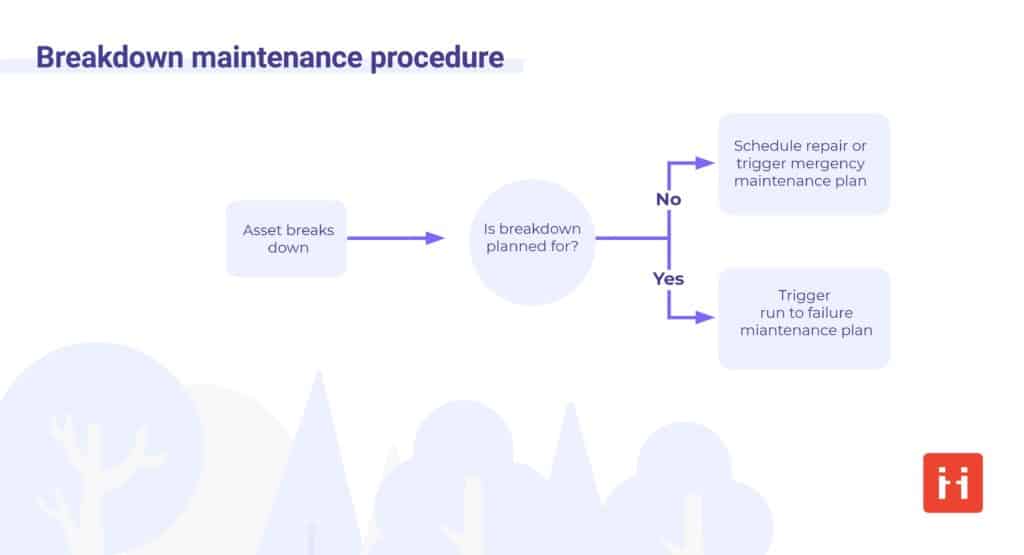
Share this article
Share this article
Breakdown scenarios are unavoidable if your organization relies on machinery in any significant capacity. Establishing clear breakdown maintenance procedures is essential if you want to minimize downtime and financial losses. The nature of a breakdown means maintenance teams are reacting to an issue, meaning you can’t plan a focused response in advance. However, you can anticipate potential issues with strategic planning to streamline your approach.
Breakdown maintenance is a style of maintenance management that waits until machinery or a piece of equipment becomes unusable before carrying out repairs. This maintenance strategy can be classified as planned or unplanned maintenance.

Run-to-failure maintenance is a standard example of a planned breakdown maintenance strategy. In these cases, companies will actively decide to let an asset fail before performing maintenance works. Generally, planned maintenance is the way to go if you’re looking for a cost-effective solution. In addition to lower overall maintenance costs, it also results in less disruption to your day-to-day operations.
Planned approaches include predictive maintenance. Specific assets are monitored regularly, with emergency maintenance carried out on an ad hoc basis. This more proactive maintenance approach results in minimal downtime and operational disruption. It’s also a cost-effective option for organizations with more modest maintenance budgets.
Unplanned maintenance generally includes reactive maintenance and corrective maintenance scenarios. In the case of corrective maintenance, repairs and fixes are carried out when an equipment failure occurs in between planned maintenance. If you have yet to establish a firm maintenance strategy, reactive maintenance is the standard approach.

Establishing well-defined standard operating procedures (SOPs) will help maintain high levels of quality control and ensure your machines are operating at maximum efficiency. SOPs will also ensure your operation is remaining compliant. What’s more, established operating procedures will streamline training and ensure all of your maintenance teams are working off the same page.
If you’re eager to implement new SOPs, make sure you’re involving your maintenance technicians in the discussion. Engaging in teamwork during maintenance planning will help you benefit from technicians’ technical insights. Additionally, they’ll be more likely to engage with procedures they’ve had a hand in creating.
We’ve gotten past the point in our evolution where the Lone Ranger is going to go out there and grab the data and solve the problem for us. We probably don’t realize the degree to which collaboration is an essential ingredient in all of this. That is the secret sauce.
Robert Golightly, Senior Manager, Product Manufacturing, AspenTech Tweet
Although exact procedures vary between organizations, the basic approach remains the same. Once an issue has been detected by a maintenance technician, the issue is immediately flagged to higher-ups. Management personnel will then create a work order, with an experienced technician or maintenance team then assigned to carry out further inspection.
These technicians will then carry out an in-depth analysis of the issue. A detailed inspection should firmly establish the details of the breakdown problem. An inspection will also determine what replacement parts are required and how much time is needed to carry out repairs. A suggested timeline for maintenance work will also be generated. If the cause of the breakdown is relatively minor, the technician carrying out the inspection may be able to resolve the problem themselves.
Once maintenance has been carried out, a technician will attempt to restart the affected asset. If the equipment restarts successfully and performs as planned, the maintenance issue is resolved and the work order can be closed.

Regardless of which maintenance approach your company is adopting, you’ll need to ensure your teams are regularly monitoring the condition and performance of your assets. You can make life easier for yourself by integrating CMMS software into your maintenance operations. Generally speaking, two main maintenance strategies fall into the breakdown category.
This style of maintenance management is associated with assets that are likely to run into issues. The run-to-failure approach means organizations are expecting their assets to stop working at some point in time and are prepared for it.
This can be a cost-effective maintenance approach for companies with relatively inexpensive assets that are easy to replace. In many cases, replacing assets outright is usually a cheaper option than budgeting for preventative maintenance. Larger organizations may also choose to adopt run-to-failure maintenance for less vital assets. Whatever the size of your business, avoid adopting this approach with systems that are crucial to your day-to-day operations. You’ll also need to consider the impact on the health and safety of your employees.
This approach to maintenance is utilized when a vital piece of machinery fails. In many cases, this downtime is unexpected, requiring immediate repair or replacement to get operations back on track.
Emergency breakdown scenarios are something every business strives to avoid when implementing new maintenance strategies. This unexpected downtime can prove incredibly costly to businesses, while also presenting unique safety risks that endanger employees. The cost of carrying out repairs also tends to be considerable. Carrying out emergency maintenance often involves bringing in the expertise of third-party technicians, spending a premium on same-day or overnight shipping, and covering the cost of overtime hours.
• Requires very little planning to implement
• Simple processes for easy adopting by maintenance teams
• Companies aren’t required to commit full-time teams to daily maintenance tasks
• Can be a relatively expensive approach to maintenance
• Difficult to predict asset and equipment failures
• Many health and safety risks to consider

If your operation depends on machinery, well-defined breakdown maintenance procedures are essential. Predictive and preventative approaches can help minimize the chance of your equipment encountering issues, but you can’t anticipate every eventuality.
Although costly, the breakdown approach to asset maintenance is a good option for smaller organizations with limited resources. Provided you’ve established standard operating procedures, you can diagnose and resolve breakdown issues quickly. By following best practices, you can expedite maintenance tasks and minimize costs. More importantly, you can take what you’ve learned forward, using insights to streamline your future approach to maintenance.
Free E-book available now!